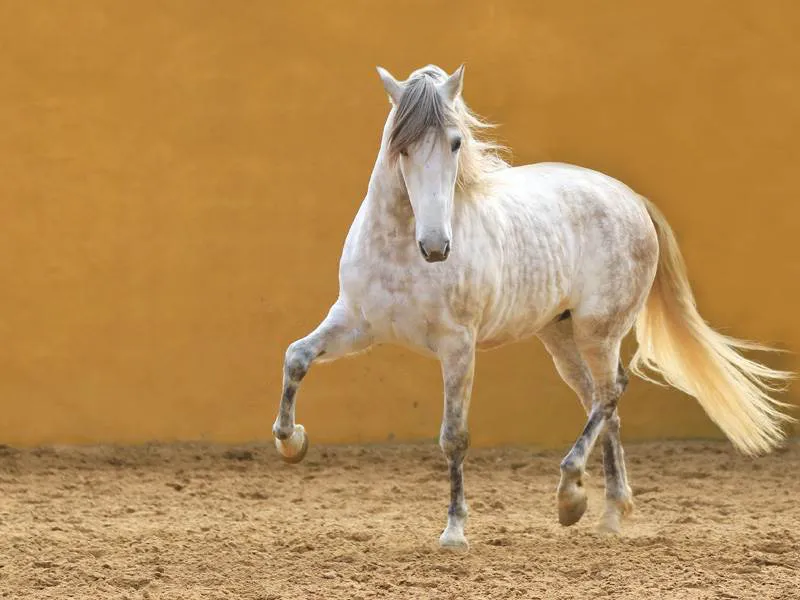Discover the unique magic of the Andalucian Horses Dance, an equine ballet accompanied by traditional Spanish music and riders in 18th century costumes performed at at the Royal Andalusian School of Equestrian Art.
By Nick Nutter | Updated 14 Dec 2023 | Cádiz | Places To Go |
Login to add to YOUR Favourites or Read Later


Andalucia Breed - PRE Guadalete VI owned by El An - Image by Petra Eckerl
The Royal Andalusian School of Equestrian Art Foundation, based in Jerez de la Frontera, is famous worldwide for its show entitled ‘Como bailan los caballos andaluces' or ‘How the Andalucian Horses Dance’. The equine ballet, first presented in 1973, is unique, as is the Andalucian horse.


Dancing Horses
It is only fair to start with the horse. Myth and legend surround the story of the origin of the Andalucian horse breed. The traditional story proceeds along the lines of: an animal native to Spain, proud and noble of course, remaining pure in breed through the centuries from the mists of time.
Recent DNA studies indicate that the breed has been in Iberia far longer than mankind, that much is true to the legend, and that there is a component of Barb horse, brought over by the Moors in the 8th century AD, in the mix, definitely not part of the myth.
The truth of the breed is even more remarkable. It is a man-made creation, produced by selective breeding since the 16th century.
That story really does start in the mists of time. About 400 BC. Simon of Athens, Xenophon, and later in the 1st century AD, Columella and Saint Isodore of Seville in about 610 AD, defined the perfect horse. Collectively they described the ‘classical horse’. It should have a small head, black eyes, tiny, straight ears, a flexible, thick and not too long neck, a thick mane, wide chest, round belly, elevated movements, a long, silky, wavy tail and a round coup. From then onwards this model of a horse, that did not exist in reality, was represented in drawings, paintings, engravings and sculptures.
In 1567, King Phillip II (the Prudent) of Spain ruled one of the world’s largest empires. His reign began the ‘Golden Age’ in Spain, a period during which there was a great outpouring of literature, music and the visual arts. Phillip allowed this blossoming of the arts to go to his head and he decided that Spain would be the country to produce what had, until then, been a fantasy - the ‘Classical horse’.
He charged the royal horse master, Diego Lopez de Haro, to purchase 1,200 mares and stallions necessary to create a new breed of horse that would match the perfect vision. Diego bought a selection of the different types of horses then in Andalucia that already had one or more of the features desired in the ideal horse. He brought them to the Royal Stables that had been built alongside the Alcázar in Córdoba city in 1570.
The eventual result was the Andalucian breed. Phillip decided the horse was so extraordinary that it would be for the exclusive use of the Royal household and for gifts to foreign monarchs, nobles and clergy. By the 18th century, the Andalucian was famous as a breed throughout the world.
Apart from being a beautiful horse, the Andalucian horse also turned out to be intelligent and athletic.
In 1973, King Juan Carlos I, then Crown Prince of Spain, awarded Don Alvaro Domecq Romero the ‘Caballo de Oro’ (Golden Horse) trophy in Jerez de la Frontera in recognition of his work with Andalucian horses. It was on this occasion that the horses from the Andalucian School of Equestrian Art first performed their ballet. The performance is accompanied by traditional Spanish music and the riders wear 18th century costumes.
In 1987, Carlos, by now King, received the Governing Body of the school at the Zarzuela Palace and accepted the post of honorary President of the school. He conferred the title of ‘Royal School’ to the Foundation.
Although the dancing horses performance is the public’s perception of the work done at the school, there are other aspects equally as important. The school is still responsible for the selection of the horses to maintain the breed. It trains Haute École riders and is responsible for the preservation of Classical and Country Dressage. Every year, the school embarks on tours to different countries, acting as ambassadors for the Province of Cadiz.
Today, the Andalucian dancing horses in Jerez are a cultural heritage that shouldn't be missed.
You can watch the ‘How the Andalucian Horses Dance’ show and marvel at the intricate choreography and equestrian skills on display. You may also want to visit the Royal Andalusian School of Equestrian Art where you can learn more the history of the Andalucian horse and even get a glimpse of their training.
Want the full experience? Then this combination ticket gives you access to both experiences.
You can check availability for your visit date below.
While in Jerez, don't miss out on the rest of the city's attractions and sights. Click here to read our full guide to Jerez de la Frontera.
Visit the official website of the Royal Andalusian School of Equestrian Art here